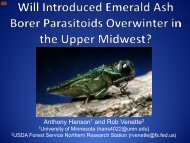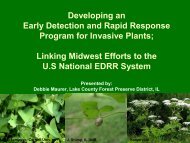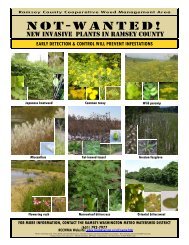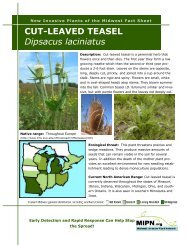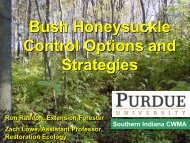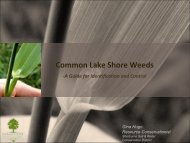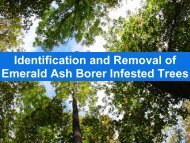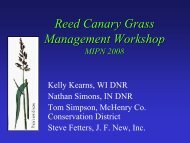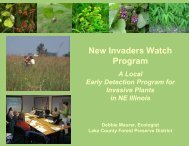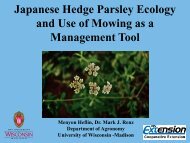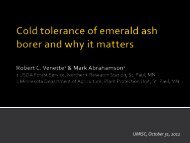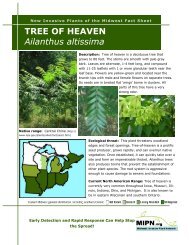Wisconsin Department of Natural Resources
Wisconsin Department of Natural Resources
Wisconsin Department of Natural Resources
You also want an ePaper? Increase the reach of your titles
YUMPU automatically turns print PDFs into web optimized ePapers that Google loves.
<strong>Wisconsin</strong> <strong>Department</strong> <strong>of</strong> <strong>Natural</strong> <strong>Resources</strong>
<strong>Wisconsin</strong> <strong>Department</strong> <strong>of</strong> <strong>Natural</strong> <strong>Resources</strong><br />
Managing Invasive Plants on Private Lands; A Multi-partner,<br />
Large-scale Approach to Control Phragmites australis<br />
(Common Reed) and Leymus arenarius (Lyme Grass)<br />
Joe Henry – District Ecologist, Bureau <strong>of</strong> Endangered <strong>Resources</strong><br />
Heidi Springborn – GLRI Project Coordinator
<strong>Wisconsin</strong> <strong>Department</strong> <strong>of</strong> <strong>Natural</strong> <strong>Resources</strong><br />
Project Overview<br />
• Fluctuating Lake Michigan water levels
<strong>Wisconsin</strong> <strong>Department</strong> <strong>of</strong> <strong>Natural</strong> <strong>Resources</strong>
<strong>Wisconsin</strong> <strong>Department</strong> <strong>of</strong> <strong>Natural</strong> <strong>Resources</strong><br />
Management Challenge<br />
• Phragmites on public and private lands<br />
• Need permission to spray private land<br />
• What will our strategy be…
<strong>Wisconsin</strong> <strong>Department</strong> <strong>of</strong> <strong>Natural</strong> <strong>Resources</strong><br />
Project Strategy<br />
• Formed a partnership comprised <strong>of</strong><br />
invested stakeholders
<strong>Wisconsin</strong> <strong>Department</strong> <strong>of</strong> <strong>Natural</strong> <strong>Resources</strong>
<strong>Wisconsin</strong> <strong>Department</strong> <strong>of</strong> <strong>Natural</strong> <strong>Resources</strong><br />
Project Strategy<br />
• Formed a partnership comprised <strong>of</strong><br />
invested stakeholders<br />
• Counties coordinated landowner<br />
contacts<br />
• Focused efforts in Conservation<br />
Opportunity Areas (COA’s)<br />
• Held 4 public meetings<br />
• Phragmites mapping
<strong>Wisconsin</strong> <strong>Department</strong> <strong>of</strong> <strong>Natural</strong> <strong>Resources</strong>
<strong>Wisconsin</strong> <strong>Department</strong> <strong>of</strong> <strong>Natural</strong> <strong>Resources</strong><br />
<strong>Wisconsin</strong> Wildlife Action Plan<br />
• which native wildlife species are most at<br />
risk,<br />
• what habitats they are associated with,<br />
• where they occur across the state, and<br />
• priority conservation actions to help “get<br />
them <strong>of</strong>f and keep them <strong>of</strong>f” any<br />
Endangered or Threatened species lists in the<br />
future.
<strong>Wisconsin</strong> <strong>Department</strong> <strong>of</strong> <strong>Natural</strong> <strong>Resources</strong><br />
<strong>Wisconsin</strong> Wildlife Action Plan<br />
• Raise awareness about the Wildlife Action Plan by<br />
communicating with WDNR staff and partners and<br />
developing outreach and training materials on how to<br />
use the Plan.<br />
• Use the Wildlife Action Plan to set conservation<br />
priorities, which will be used to determine priorities for<br />
State Wildlife Grant funds.<br />
• Work with WDNR staff and partners to integrate the<br />
Wildlife Action Plan into existing planning, management<br />
and budgeting processes.
<strong>Wisconsin</strong> <strong>Department</strong> <strong>of</strong> <strong>Natural</strong> <strong>Resources</strong><br />
Species <strong>of</strong> Greatest Conservation Need<br />
Caspian Tern<br />
Arctic Primrose<br />
Forster’s Tern<br />
Ohio Goldenrod<br />
Hines Emerald<br />
Dwarf Lake Iris<br />
Piping Plover
<strong>Wisconsin</strong> <strong>Department</strong> <strong>of</strong> <strong>Natural</strong> <strong>Resources</strong><br />
Project Strategy – con’t<br />
• Aerial spray 3315 acres spanning 54 miles<br />
• Ground spray 285 acres spanning 63 miles<br />
• 3 years <strong>of</strong> control<br />
• Phragmites mapping<br />
Utilized GIS and GPS systems<br />
DCIST ≥45 volunteers mapped over<br />
50 acres
<strong>Wisconsin</strong> <strong>Department</strong> <strong>of</strong> <strong>Natural</strong> <strong>Resources</strong><br />
Mapping Techniques<br />
Bay <strong>of</strong> Green Bay<br />
Rare Plant Mapping
<strong>Wisconsin</strong> <strong>Department</strong> <strong>of</strong> <strong>Natural</strong> <strong>Resources</strong><br />
Mapping Techniques<br />
DCIST Women<br />
DCIST Men
<strong>Wisconsin</strong> <strong>Department</strong> <strong>of</strong> <strong>Natural</strong> <strong>Resources</strong><br />
Project Strategy – con’t<br />
• Aerial spray 3315 acres spanning 55 miles<br />
• Ground spray 285 acres spanning 63 miles<br />
• 3 years <strong>of</strong> control<br />
• Phragmites mapping<br />
Utilized GIS and GPS systems<br />
DCIST ≥45 volunteers mapped over<br />
50 acres<br />
• Establish monitoring plots
<strong>Wisconsin</strong> <strong>Department</strong> <strong>of</strong> <strong>Natural</strong> <strong>Resources</strong><br />
Project Implementation<br />
• September 2011 – Aerial treatments<br />
begin<br />
• Spray north to south
<strong>Wisconsin</strong> <strong>Department</strong> <strong>of</strong> <strong>Natural</strong> <strong>Resources</strong><br />
Aerial Spraying
<strong>Wisconsin</strong> <strong>Department</strong> <strong>of</strong> <strong>Natural</strong> <strong>Resources</strong><br />
1291 acres<br />
2987 acres sprayed!<br />
735 acres<br />
910 acres<br />
51 acres
<strong>Wisconsin</strong> <strong>Department</strong> <strong>of</strong> <strong>Natural</strong> <strong>Resources</strong><br />
Project Implementation – con’t<br />
• September 2011 – Aerial treatments<br />
began<br />
• Spray north to south<br />
• September 2011 – Ground treatments<br />
began
<strong>Wisconsin</strong> <strong>Department</strong> <strong>of</strong> <strong>Natural</strong> <strong>Resources</strong>
<strong>Wisconsin</strong> <strong>Department</strong> <strong>of</strong> <strong>Natural</strong> <strong>Resources</strong>
<strong>Wisconsin</strong> <strong>Department</strong> <strong>of</strong> <strong>Natural</strong> <strong>Resources</strong>
<strong>Wisconsin</strong> <strong>Department</strong> <strong>of</strong> <strong>Natural</strong> <strong>Resources</strong>
<strong>Wisconsin</strong> <strong>Department</strong> <strong>of</strong> <strong>Natural</strong> <strong>Resources</strong>
<strong>Wisconsin</strong> <strong>Department</strong> <strong>of</strong> <strong>Natural</strong> <strong>Resources</strong>
<strong>Wisconsin</strong> <strong>Department</strong> <strong>of</strong> <strong>Natural</strong> <strong>Resources</strong><br />
Spray Results<br />
• A lot <strong>of</strong> dead stuff – Year 1
<strong>Wisconsin</strong> <strong>Department</strong> <strong>of</strong> <strong>Natural</strong> <strong>Resources</strong><br />
735 acres<br />
1291 acres<br />
910acres<br />
10 acres<br />
51 acres<br />
15 acres<br />
183 acres
<strong>Wisconsin</strong> <strong>Department</strong> <strong>of</strong> <strong>Natural</strong> <strong>Resources</strong><br />
Spray Results – con’t<br />
• Aerial spray 2987 acres<br />
• Ground spray 317.1 acres<br />
- Door – 183 acres DNR, 68 acres contract<br />
- Marinette – 34.6 acres contract<br />
- Oconto – 5 acres DNR, 4 acres contract<br />
- Manitowoc – 23.5 acres contract<br />
- Sheboygan – 10 acres DNR
<strong>Wisconsin</strong> <strong>Department</strong> <strong>of</strong> <strong>Natural</strong> <strong>Resources</strong><br />
Plant Community Response to Herbicide<br />
Low Density Patches (above OHWM) – mainly sedge meadow<br />
• 1 st year – collateral damage on adjacent plants<br />
• 2 nd and 3 rd year – good native rebound<br />
Lake Shore (below OHWM) – mainly swales and beaches<br />
• 1 st year – collateral damage on natives but noticeable<br />
(moderate) response<br />
• 2 nd year – very good recovery<br />
* Lake shore has good seed bank present and native species<br />
recovery tends to occur faster here than in sedge<br />
meadow areas
<strong>Wisconsin</strong> <strong>Department</strong> <strong>of</strong> <strong>Natural</strong> <strong>Resources</strong>
<strong>Wisconsin</strong> <strong>Department</strong> <strong>of</strong> <strong>Natural</strong> <strong>Resources</strong>
<strong>Wisconsin</strong> <strong>Department</strong> <strong>of</strong> <strong>Natural</strong> <strong>Resources</strong>
<strong>Wisconsin</strong> <strong>Department</strong> <strong>of</strong> <strong>Natural</strong> <strong>Resources</strong><br />
Project Implementation – con’t<br />
• Ideally everything will be treated in 2011<br />
* 328 acres short for aerial, exceeded<br />
ground goal by 15 acres<br />
• Follow-up spraying in 2012 and 2013<br />
• Some areas missed in 2011 will get initial<br />
treatment in 2012<br />
• Minimally all acres will receive 1 year <strong>of</strong><br />
follow-up but most will receive 2 years
<strong>Wisconsin</strong> <strong>Department</strong> <strong>of</strong> <strong>Natural</strong> <strong>Resources</strong><br />
Take Home Messages<br />
• Large-scale is not required to apply the<br />
strategy used here<br />
• Partners found consensus on unifying<br />
issue but goals were different<br />
• Volunteer/partnership made the project<br />
possible (private land critical to success)<br />
• Grant $ was significant but apply funding<br />
available to the allowable scale<br />
• Would we do it again
<strong>Wisconsin</strong> <strong>Department</strong> <strong>of</strong> <strong>Natural</strong> <strong>Resources</strong><br />
Lessons Learned<br />
• Mapping – predetermine naming<br />
conventions<br />
• Predetermine projection system if using<br />
ArcMap s<strong>of</strong>tware<br />
• QA/QC spray blocks with contractors<br />
prior to spraying<br />
• Consistent and clear communication<br />
• Hire contractors sooner
<strong>Wisconsin</strong> <strong>Department</strong> <strong>of</strong> <strong>Natural</strong> <strong>Resources</strong><br />
Any Questions????





